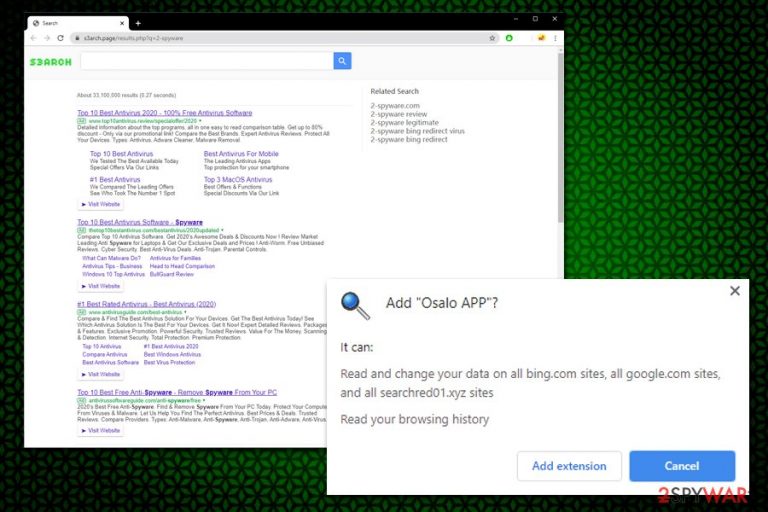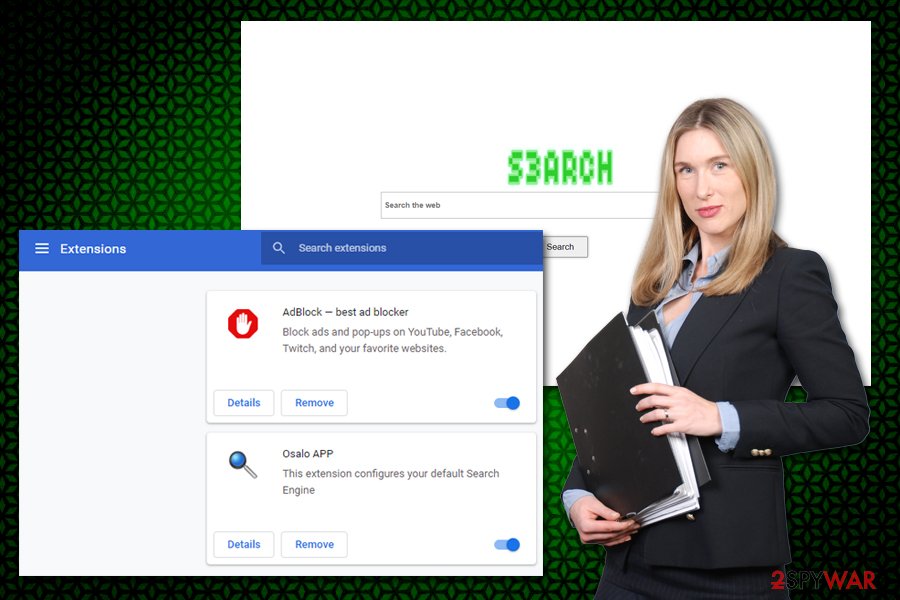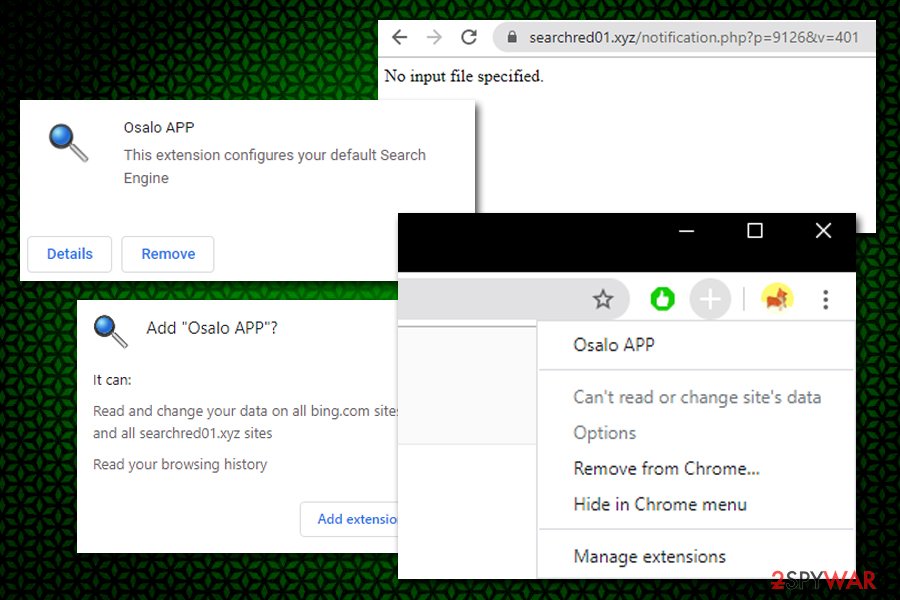Osalo APP (Removal Guide) - Free Instructions
Osalo APP Removal Guide
What is Osalo APP?
Osalo APP – potentially unwanted program that hijacks your searches to deliver sponsored content

Osalo APP is a browser hijacker that might get installed on your Google Chrome, Mozilla Firefox, Safari, or another web browser without permission, although it is also available on official sources, so intentional installation is also possible. The authors of this potentially unwanted program claim that there is a “whole new world of browsing today with just a simple click,” initially stating that the extension will provide improved search results around the web.
However, Osalo APP hijack is applied only with one goal in mind – to make users click on ads, which grants the app developers and some third-parties financial benefits. While many other hijackers are immediately visible, this app use deception to hide its existence in the first place – the homepage and the new tab are not altered visually, although all searchers are performed via searchmes.xyz and s3arch.page sites, which return a multitude of sponsored links.
| Name | Osalo APP |
| Type | Browser hijacker, potentially unwanted program |
| Sub-type | Search hijacker |
| Infiltration | Potentially unwanted applications might be installed intentionally via the official sources such as Chrome Web Store, although they can also be delivered via deceptive methods, such as software bundling or fake Flash Player update prompts |
| Symptoms |
|
| Risks | Installation of other potentially unwanted software, personal information disclosure due to excessive tracking practices, financial losses, malware infections, etc. |
| Removal | You can uninstall the extension manually as per instructions below or use powerful anti-malware software |
| System fix | We recommend using FortectIntego to repair system after malware/PUP elimination |
Browser hijackers like Babylon Toolbar or Pup.optional.ask were extremely prevalent threats that used to appear on users' web browsers seemingly out of nowhere. Unfair distribution practices and deception were common, and most unaware users had cluttered web browser UIs due to a multitude of malicious apps installed. Personal data tracking was common practice, and persistence techniques were applied to prevent users from removing malicious apps from their web browsers. Luckily, some industry giants took steps to handle these terrible browser add-ons for good.[1]
Many things changed, however, and web browsers such as Google Chrome is now warning about the incoming web browser changes and also displays information about what permissions the app requires post-installation. As previously mentioned, Osalo APP might be installed via software bundle packages, deceptive ads, or via the official sources. Nonetheless, this app causes much more troubles than it might initially seem.
All browser hijackers operate a relatively similar scheme – they pretend that the functionality that they provide is extremely useful (in most cases, developers boast about “enhanced” search results”), alter web browser settings in order to track users in various ways and then display them ads and sponsored links, monetizing on the scheme in the process. Only this behavior is considered unwelcome and should warrant Osalo APP removal.
Upon installation of Osalo APP virus, Google Chrome warns about the following:
Add “Osalo APP”?
It can:
Read and change your data on all bing.com sites, google.com sites, and all searchred01.xyz sites.
Read your browsing history.
This statement is extremely alarming, as it allows reading all the information that is being entered into these popular websites. Additionally, Osalo APP can also track your browsing history, essentially reading data about your browsing habits. Despite that the app is available on an official store, it does not provide a link to Privacy Policy; hence the full scope of data tracking is unknown.

Those who would want to remove Osalo APP might also be disappointing, as there are several tricks that the developer uses to prevent users from doing just that:
- When the browser is launched or the new tab accessed, no URL or visual changes can be observed (i.e., there is no initial visual representation of the hijacking);
- Extensions are meant to have visible icons within the browser. Osalo APP provides an obscure image of a “plus” sign which blends with the background;
- Once trying to access the extension details within Chrome browser settings, “No input file specified” error is delivered.
Luckily, you can get rid of Osalo APP by right-clicking on the extension quite easily. Nevertheless, due to deceptive practices of this PUP, we highly recommend also scanning the machine with potent anti-malware software to ensure all the elements are eliminated. Additionally, experts[2] recommend checking the installed apps section on the computer to check for other potentially unwanted software.
Finally, if you still see Osalo APP redirects, it might be that some traces of the PUP remained on your web browser. In such a case, check the instructions below for a full browser reset. Additionally, for the best results, we recommend scanning the machine with FortectIntego.
Search and browser hijackers are useless, and you should stay away from them
Browser extensions are useful features that can help users customize their web experience and equip them with various useful features. However, some add-ons are not created for mutual benefits but rather only those of the developer – they do not provide any useful functions (in some cases, they might even break the functionality of the web browser or other applications/extensions) but instead feed users with ads, all while gathering, retaining and sharing their details with third-parties.
Therefore, It is always important to differentiate between a good and a bad application prior to its installation. For that, we first recommend installing an anti-malware application that includes PUP detection feature, as security vendors now use extensive databases that include deceptive add-ons or apps. Since not all unwanted or/and malicious programs can be detected at all times, we advise being vigilant when online:
- Do not trust ads that claim virus infections or that something (e.g., Java, Flash Player) is missing from your computer;
- If possible, use official sources such as Microsoft Store, App Store or Chrome Web Store for your installs;
- Read reviews on apps you are about to install;
- During the installation, always opt for Advanced settings instead of Recommended ones;
- Eliminate ticks from the pre-ticked boxes, read fine print, and watch out for other tricks that are used by third-party sites and freeware[3] authors.

Eliminate Osalo APP and other unwanted programs from your system
While this browser extension uses various deception techniques, there should not be an issue when trying to remove Osalo APP. If you are using Chrome, Firefox, or Safari, all you have to do is right-click on an almost invisible icon of the app and select “Remove from Chrome” or “Remove Extension.” However, since browser hijackers often leave several settings behind, we also recommend resetting all the installed web browsers, as we explain below.
However, Osalo APP removal might not be enough to stop browser redirects, ads, and online tracking, as there might be programs installed on your system that you might not be aware of. In such a case, you can access the list of all the installed applications and uninstall everything you do not recognize. On the other hand, a scan with a reputable anti-malware software would be able to get rid of the Osalo APP virus, as well as most of the PUPs installed on your machine.
You may remove virus damage with a help of FortectIntego. SpyHunter 5Combo Cleaner and Malwarebytes are recommended to detect potentially unwanted programs and viruses with all their files and registry entries that are related to them.
Getting rid of Osalo APP. Follow these steps
Uninstall from Windows
To uninstall potentially unwanted applications from Windows systems, please follow these steps:
Instructions for Windows 10/8 machines:
- Enter Control Panel into Windows search box and hit Enter or click on the search result.
- Under Programs, select Uninstall a program.

- From the list, find the entry of the suspicious program.
- Right-click on the application and select Uninstall.
- If User Account Control shows up, click Yes.
- Wait till uninstallation process is complete and click OK.

If you are Windows 7/XP user, proceed with the following instructions:
- Click on Windows Start > Control Panel located on the right pane (if you are Windows XP user, click on Add/Remove Programs).
- In Control Panel, select Programs > Uninstall a program.

- Pick the unwanted application by clicking on it once.
- At the top, click Uninstall/Change.
- In the confirmation prompt, pick Yes.
- Click OK once the removal process is finished.
Delete from macOS
Remove items from Applications folder:
- From the menu bar, select Go > Applications.
- In the Applications folder, look for all related entries.
- Click on the app and drag it to Trash (or right-click and pick Move to Trash)

To fully remove an unwanted app, you need to access Application Support, LaunchAgents, and LaunchDaemons folders and delete relevant files:
- Select Go > Go to Folder.
- Enter /Library/Application Support and click Go or press Enter.
- In the Application Support folder, look for any dubious entries and then delete them.
- Now enter /Library/LaunchAgents and /Library/LaunchDaemons folders the same way and terminate all the related .plist files.

Remove from Microsoft Edge
Delete unwanted extensions from MS Edge:
- Select Menu (three horizontal dots at the top-right of the browser window) and pick Extensions.
- From the list, pick the extension and click on the Gear icon.
- Click on Uninstall at the bottom.

Clear cookies and other browser data:
- Click on the Menu (three horizontal dots at the top-right of the browser window) and select Privacy & security.
- Under Clear browsing data, pick Choose what to clear.
- Select everything (apart from passwords, although you might want to include Media licenses as well, if applicable) and click on Clear.

Restore new tab and homepage settings:
- Click the menu icon and choose Settings.
- Then find On startup section.
- Click Disable if you found any suspicious domain.
Reset MS Edge if the above steps did not work:
- Press on Ctrl + Shift + Esc to open Task Manager.
- Click on More details arrow at the bottom of the window.
- Select Details tab.
- Now scroll down and locate every entry with Microsoft Edge name in it. Right-click on each of them and select End Task to stop MS Edge from running.

If this solution failed to help you, you need to use an advanced Edge reset method. Note that you need to backup your data before proceeding.
- Find the following folder on your computer: C:\\Users\\%username%\\AppData\\Local\\Packages\\Microsoft.MicrosoftEdge_8wekyb3d8bbwe.
- Press Ctrl + A on your keyboard to select all folders.
- Right-click on them and pick Delete

- Now right-click on the Start button and pick Windows PowerShell (Admin).
- When the new window opens, copy and paste the following command, and then press Enter:
Get-AppXPackage -AllUsers -Name Microsoft.MicrosoftEdge | Foreach {Add-AppxPackage -DisableDevelopmentMode -Register “$($_.InstallLocation)\\AppXManifest.xml” -Verbose

Instructions for Chromium-based Edge
Delete extensions from MS Edge (Chromium):
- Open Edge and click select Settings > Extensions.
- Delete unwanted extensions by clicking Remove.

Clear cache and site data:
- Click on Menu and go to Settings.
- Select Privacy, search and services.
- Under Clear browsing data, pick Choose what to clear.
- Under Time range, pick All time.
- Select Clear now.

Reset Chromium-based MS Edge:
- Click on Menu and select Settings.
- On the left side, pick Reset settings.
- Select Restore settings to their default values.
- Confirm with Reset.

Remove from Mozilla Firefox (FF)
Remove dangerous extensions:
- Open Mozilla Firefox browser and click on the Menu (three horizontal lines at the top-right of the window).
- Select Add-ons.
- In here, select unwanted plugin and click Remove.

Reset the homepage:
- Click three horizontal lines at the top right corner to open the menu.
- Choose Options.
- Under Home options, enter your preferred site that will open every time you newly open the Mozilla Firefox.
Clear cookies and site data:
- Click Menu and pick Settings.
- Go to Privacy & Security section.
- Scroll down to locate Cookies and Site Data.
- Click on Clear Data…
- Select Cookies and Site Data, as well as Cached Web Content and press Clear.

Reset Mozilla Firefox
If clearing the browser as explained above did not help, reset Mozilla Firefox:
- Open Mozilla Firefox browser and click the Menu.
- Go to Help and then choose Troubleshooting Information.

- Under Give Firefox a tune up section, click on Refresh Firefox…
- Once the pop-up shows up, confirm the action by pressing on Refresh Firefox.

Remove from Google Chrome
In case Osalo APP redirects and ads do not go away, reset Google Chrome as explained below:
Delete malicious extensions from Google Chrome:
- Open Google Chrome, click on the Menu (three vertical dots at the top-right corner) and select More tools > Extensions.
- In the newly opened window, you will see all the installed extensions. Uninstall all the suspicious plugins that might be related to the unwanted program by clicking Remove.

Clear cache and web data from Chrome:
- Click on Menu and pick Settings.
- Under Privacy and security, select Clear browsing data.
- Select Browsing history, Cookies and other site data, as well as Cached images and files.
- Click Clear data.

Change your homepage:
- Click menu and choose Settings.
- Look for a suspicious site in the On startup section.
- Click on Open a specific or set of pages and click on three dots to find the Remove option.
Reset Google Chrome:
If the previous methods did not help you, reset Google Chrome to eliminate all the unwanted components:
- Click on Menu and select Settings.
- In the Settings, scroll down and click Advanced.
- Scroll down and locate Reset and clean up section.
- Now click Restore settings to their original defaults.
- Confirm with Reset settings.

Delete from Safari
Remove unwanted extensions from Safari:
- Click Safari > Preferences…
- In the new window, pick Extensions.
- Select the unwanted extension and select Uninstall.

Clear cookies and other website data from Safari:
- Click Safari > Clear History…
- From the drop-down menu under Clear, pick all history.
- Confirm with Clear History.

Reset Safari if the above-mentioned steps did not help you:
- Click Safari > Preferences…
- Go to Advanced tab.
- Tick the Show Develop menu in menu bar.
- From the menu bar, click Develop, and then select Empty Caches.

After uninstalling this potentially unwanted program (PUP) and fixing each of your web browsers, we recommend you to scan your PC system with a reputable anti-spyware. This will help you to get rid of Osalo APP registry traces and will also identify related parasites or possible malware infections on your computer. For that you can use our top-rated malware remover: FortectIntego, SpyHunter 5Combo Cleaner or Malwarebytes.
How to prevent from getting browser hijacker
Stream videos without limitations, no matter where you are
There are multiple parties that could find out almost anything about you by checking your online activity. While this is highly unlikely, advertisers and tech companies are constantly tracking you online. The first step to privacy should be a secure browser that focuses on tracker reduction to a minimum.
Even if you employ a secure browser, you will not be able to access websites that are restricted due to local government laws or other reasons. In other words, you may not be able to stream Disney+ or US-based Netflix in some countries. To bypass these restrictions, you can employ a powerful Private Internet Access VPN, which provides dedicated servers for torrenting and streaming, not slowing you down in the process.
Data backups are important – recover your lost files
Ransomware is one of the biggest threats to personal data. Once it is executed on a machine, it launches a sophisticated encryption algorithm that locks all your files, although it does not destroy them. The most common misconception is that anti-malware software can return files to their previous states. This is not true, however, and data remains locked after the malicious payload is deleted.
While regular data backups are the only secure method to recover your files after a ransomware attack, tools such as Data Recovery Pro can also be effective and restore at least some of your lost data.
- ^ Ian Paul. Microsoft's good deed for the day: browser-hijacking Ask Toolbar gets the banhammer on Windows. PCWrold. News, tips and reviews from the experts on PCs.
- ^ Bedynet. Bedynet. Cybersecurity advice and malware insights.
- ^ Tim Fisher. What Is Freeware?. Lifewire. Tech News, Reviews, Help & How-Tos.
